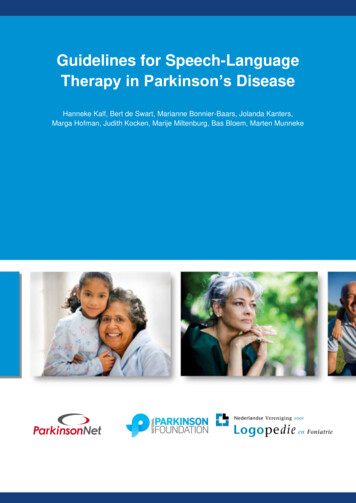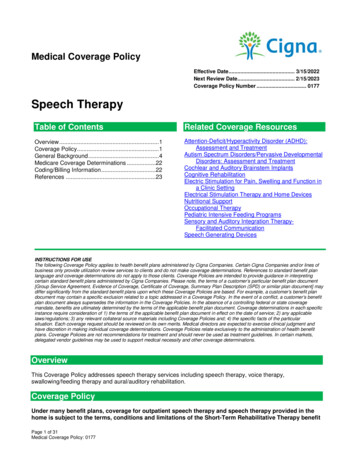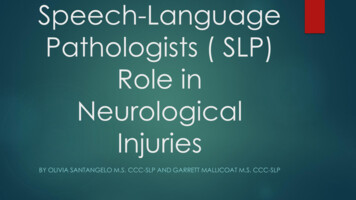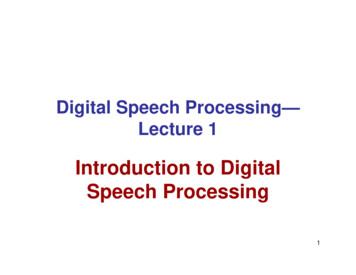
Transcription
Guidelines for Speech-LanguageTherapy in Parkinson’s DiseaseHanneke Kalf, Bert de Swart, Marianne Bonnier-Baars, Jolanda Kanters,Marga Hofman, Judith Kocken, Marije Miltenburg, Bas Bloem, Marten Munneke(c) ParkinsonNet/NPF5
Kalf JG, de Swart BJM, Bonnier M, Hofman M, Kanters J, Kocken J, Miltenburg M,Bloem BR, Munneke M. Guidelines for speech-language therapy in Parkinson’sdisease. Nijmegen, The Netherlands / Miami (FL), U.S.A.: ParkinsonNet/NPF.Originally published in Dutch as Logopedie bij de ziekte van Parkinson. Een richtlijn van deNederlandse Vereniging voor Logopedie en Foniatrie. 2008 NVLF, Woerden 2008/LemmaPublishers. A guideline developed under supervision of the Parkinson Centre Nijmegen,commissioned by the NVLF (Dutch Association of Logopedics and Phoniatrics) . Thedevelopment of the guideline was financially supported by the Dutch Parkinson’s diseaseSociety and Fonds NutsOhra.Translation of the guideline is financially supported by the National Parkinson Foundation(NPF, www.Parkinson.org). The guideline is translated by under supervision of RadboudUniversity Nijmegen Medical Centre, Department of Neurology, ParkinsonNet(www.ParkinsonNet.nl), SHJ Keus and JG Kalf. 2011 ParkinsonNet/National Parkinson Foundation (NPF)All rights reserved. No part of this publication may be reproduced, transmitted or stored in aretrieval system of any nature, in any form or by any means, or, without prior permission inwriting of the copyright owner.(c) ParkinsonNet/NPF6
Preface to the English translationThe English version of this guideline is a direct translation of the complete Dutch textpublished in 2008 (see copyright & credits), except for a few minor corrections andadaptations to increase comprehension.The guideline has been developed in accordance with international standards for guidelinedevelopment. In addition to internationally published evidence and expert opinion, the expertopinion of the Dutch guideline working group has been used for development of therecommendations. Accordingly, the specific vision and context of speech-language therapyin the Netherlands may emerge in the choice of key questions, in the reference to Dutchhandbooks and under “other considerations” (e.g. concerning the organization of healthcareor the availability of resources, and training of therapists). The user of this guideline shouldbear in mind that this context may differ from the context in other countries. Nevertheless, webelieve that this guideline is the first to describe best practice in speech-language therapy inParkinson’s disease rehabilitation, according to international standards of guidelinedevelopment and covering both assessments and interventions.(c) ParkinsonNet/NPF7
PrefaceWith justifiable pride, we recommend this guideline to you.The fact is that this is not just any guideline. It is an evidence-based guideline for speech-languagetherapy. What’s more, it has a “twin” in occupational therapy. As far as we know, it is unique for twomonodisciplinary evidence-based guidelines in allied health professions to come out at the same time:Occupational Therapy in Parkinson’s Disease and Speech and Language Therapy in Parkinson’sDisease, guidelines from the Dutch Association of Occupational Therapy (Ergotherapie Nederland)and the Dutch Association of Logopedics and Phoniatrics (Nederlandse Vereniging voor Logopedie enFoniatrie; NVLF). These guidelines were developed simultaneously and in close collaboration.The primary aim of developing a guideline is to guarantee the level of care and, where possible, toimprove it by making it more efficient and effective. By effective, we mean safer, more acceptable toboth the person providing treatment and the client; and more applicable and practicable. In otherwords, guidelines are necessary and useful because they create standards for the content, provisionand organization of care.A new guideline is an important innovation because it bundles the best available scientific evidence. Itis innovative in the sense that the evidence is viewed from a practical perspective. A guidelineprovides professionals with valuable recommendations about good and proper care. A practicalguideline describes the care content from the available scientific evidence and incorporates theexperiences of therapists and clients. The provision of care is, after all, based on a partnershipbetween the client and therapist. Moreover, it is aimed at participation and is thus context-oriented. Butthis guideline offers even more than this. The group of researchers and professionals from Nijmegencollaborated intensively on these guidelines. Not only does the correlation between the guidelines andthe Parkinson’s Disease Guideline of the Royal Dutch Society for Physical Therapy (KNGF) from 2004provide a solid foundation for monodisciplinary treatment, it also facilitates the collaboration betweenthe various allied health disciplines. It is precisely this collaboration that is a critical factor of successfor the provision of good care in which the needs of the client are served. Integrated care plays anincreasingly important role in how the quality of care is experienced.As Cervante’s character, Don Quixote, said in 1605, “the proof of the pudding is in the eating.” Thisguideline’s value will have to be proven in practice. Before that happens – before speech-languagepathologists actually begin to apply the guideline in practice – an implementation process will have tobe completed. This is an important task for the professional associations.To our great satisfaction, steps have already been taken to evaluate the use of the guidelines throughscientific study. This will make it possible to determine the extent of the application of the guidelines indetail and, for example, to study the relationships between the application of the guidelines and theoutcome of the care.We would like to pay our compliments to the following individuals in this classic example ofstrengthening care - its content, provision and organization - through collaboration!Dr. Chris Kuiper, Scientific directorThe Dutch Association of Occupational Therapy (Ergotherapie Nederland)Marjolein Coppens (MSc)Speech and language therapy researcherMember of association board and chair of professional content commission (Commissie Vakinhoud)Dutch Association for Logopedics and Phoniatrics (NVLF)(c) ParkinsonNet/NPF8
ContentsPart I: Introduction and summary101. Speech-language pathology domains in Parkinson’s disease112. Patient management123. Overview of the recommendations14Summary cards26Part II: Explanation and justification281. General introduction and justification292. Parkinson’s disease373. Dysarthria and communication534. Dysphagia785. Drooling92Appendices:981. Contributors to the guideline2. Sample questions for taking a patient’s history of speech and languageimpairments in Parkinson’s disease3. Questionnaire on dysarthria in Parkinson’s disease4. Nijmegen Dysarthria Scale (NDS)5. Rating form for dysarthria and language production6. Sample questions for taking patient’s history of oropharyngeal dysphagia inParkinson’s disease7. Questionnaire on dysphagia in Parkinson’s disease8. Sample questions for taking patient’s history of drooling in Parkinson’sdisease9. Drooling Severity and Frequency Scale, modified for Parkinson’s disease(DSFS-P)10. Questionnaire on drooling in Parkinson’s disease11. Medication for Parkinson’s disease12. Overview of desired evidence13. Evidence tables99102References124(c) ParkinsonNet/NPF1031051071091121141151181181191209
PART IIntroduction and summary(c) ParkinsonNet/NPF10
Speech-language pathology in Parkinson’s diseaseThis is Part I, an introduction to and summary of the “Guideline for speech-languagepathology in Parkinson’s Disease” from the Dutch Association of Logopedics and Phoniatrics(NVLF), which can be read separately from the guideline itself. Part II of the guidelineconsists of the full justification, the backgrounds to the recommendations and theappendices.Part I consists of three sections: (1) the speech-language pathology domains in Parkinson’sdisease (PD), (2) patient management and (3) a summary of all key questions andrecommendations.1. Speech-language pathology domains in Parkinson’s diseaseWith respect to Parkinson’s disease, speech-language pathology focuses on three domains:– difficulty with speech: hypokinetic dysarthria and the influence of cognitive impairmentson language comprehension, language use and communication skills– difficulty with chewing and swallowing: dysphagia, choking and slow chewing andswallowing– difficulty with controlling saliva: drooling or dribbling of salivaFor the rehabilitation of persons with Parkinson’s disease (PwP), Morris & Iansek (1) havedescribed a theoretical model which has been met with positive experiences in largeParkinson's centers abroad. This model consists of the following five basic assumptions (p.12):1. “Normal movement is possible in Parkinson’s disease; what is required is appropriateactivation. The skilled therapist is able to determine the most effective methods toactivate normal movement.2. Complex movements need to be broken down into smaller components. This is to avoidmotor instability and to take advantage of increased amplitude at the beginning ofmovement sequences.3. Each component of a task needs to be performed at a conscious level. Consciousattention appears to bypass the basal ganglia and restore movement towards normal.4. External cues may be used to initiate and maintain movement and cognitive processes.Visual, auditory or proprioceptive cues may be used. Cues indicate the appropriatemovement size and appear to activate attentional motor control mechanisms.5. Simultaneous motor or cognitive tasks are to be avoided. This is because the moreautomatic task is not executed properly and only the task demanding attention issatisfactorily completed.”These assumptions are also relevant in speech-language treatment (2).Evaluation and treatment of limitations in speechSubtle changes in a patient’s speech and cognition can have a large impact on the degree towhich the patient feels comfortable with speaking (already early in the disease) (3). Thisunderscores the importance of early referral and timely attention from a speech-languagepathologist (SLP).(c) ParkinsonNet/NPF11
The current speech-language treatment techniques related to hypokinetic dysarthria focus onan intensive stimulation of the intensity of the speech, over a period of at least four weeks.This kind of approach is specific for PD, because it puts demands on the – to a certain extent– normal motor skills by activating and stimulating them with cues. Various studies (4) haveshown the value of this approach for patients with Parkinson’s disease.PwPs vary significantly with respect to the severity of the disease, physical and cognitivecapacity, dysarthric features and expectations regarding verbal communication. This meansthat the treatment to improve intelligibility can range from a one-time consultation withrecommendations to intensive treatment of at least three sessions per week over the courseof at least four weeks, to periodic consultations with a focus on supervising and instruction ofcaregivers (conversational partners). The treatment of communication disorders resultingfrom cognitive deterioration and language impairments is limited to recommendations andspecific modifications. A physician, referring a patient with PD may expect that an SLP withexperience in PD is capable of evaluating whether, and in what way, treatment is worthwhileand carrying out this treatment.Evaluation and treatment of limitations to swallowingChoking, slowness of chewing and other typical swallowing problems in PD can beworrisome and a burden to the patient and his caregivers (5). After an efficient assessment,SLPs who have experience with the treatment of dysphagia related to PD are capable ofproviding adequate exercises, modifications, cues and movement strategies. The treatmentthat follows will generally consist of a one-time session or a short treatment period, ifnecessary in the domestic setting.Evaluation and treatment of limitations in saliva controlDrooling is an unpleasant problem that appears primarily in the later phases of the disease.SLPs experienced in the treatment of drooling can determine the severity of the problem andto what extent it can be treated. Treatment generally consists of either one-timerecommendations or a short treatment period, when needed in the domestic setting. Ifspeech-language therapy is ineffective, the SLP will refer the PwP back to the neurologist formedical treatment (e.g. injections with botulinum-neurotoxin).2. Patient managementThe patient management in speech-language therapy is described in the Speech-LanguagePathology Standards (Logopedische Standaarden) for the various fields in which the speechlanguage pathologist can work (NVLF, 1996).The key questions and recommendations of the guideline generally follow these steps inpatient management (see Fig. 1):(c) ParkinsonNet/NPF12
Figure 1. The phases of patient managementIndication and referralHistoryDiagnostic assessmentTreatmentEvaluation and reportIn 2009 a multidisciplinary guideline for the assessment and treatment of PD(Multidisciplinaire richtlijn voor diagnostiek en behandeling van de ziekte van Parkinson) waspublished under the direction of the Dutch Institute for Healthcare Improvement (CBO) (6).Among other things, this guideline describes the indication for the various disciplines in PDand agreements on the reporting between the referrer and the health professionals. For thisreason, the recommendations regarding the indication for speech-language treatment in PDand the reporting between the referrer and the SLP have been included in this guideline(according to the structure of the recommendations, see Part II, Chapter 1).Question 1What are the indications for referral to a speech-language pathologist?Other considerationsThe draft of the PD-guideline (Logopedie bij de ziekte van Parkinson) from the DutchAssociation of Logopedics and Phoniatrics (NVLF) was followed in formulating thisrecommendation.Recommendation 1Indications for referral to a speech-language pathologist are:1. The presence of limitations in speech or communication.2. The presence of limitations in swallowing (with drooling as a possible result) or problemswith eating/drinking due to dysphagia (with aspiration pneumonia or weight loss as apossible result).3. The need for advice and the use of aids to facilitate communication.(c) ParkinsonNet/NPF13
Question 2What are the conditions for working agreements between the health professionals involved?The multidisciplinary guideline includes recommendations on the manner of reporting,meaning which information the SLP may expect from the referrer and which information doesthe referrer like to receive back from an SLP in a treatment report or letter.Other considerationsTo guarantee optimal continuity of care, good working agreements between the healthprofessionals involved are essential, in which the PD nurse or care coordinator plays a keyrole.Recommendation 2aThe letter of referral to a health professional involved in the indication should at least contain:(a) the medical case history, (b) the comorbidity, (c) the current medication and, preferably,the previously used medication (including the reasons for discontinuation), (d) theassessment conclusion and (e) the nature of the referral (a one-time advisory consultation orthe initiation of an intervention).Recommendation 2bThe health professional to which the patient has been referred reports to the referrer (and tothe PD nurse) when the treatment is completed. If a treatment spans a longer period, thehealth professional will also make interim reports (at least once per year). In the report, thehealth professional will state at least the implemented intervention(s), the treatment periodand frequency, the effect and the expected prognosis. If possible, the intervention resultsshould be supported by values derived from measuring tools used. The significance of thesevalues should be succinctly – but clearly – described. If a monodisciplinary guideline isavailable, the reporting and the selection of measuring tools should be in accordance withthis guideline. When psychosocial problems and/or fluctuations in response to medicationare observed, this is reported to the PD nurse or care coordinator.Below, for each area, the guideline provides recommendations on speech and languagepathology assessment and the intervention options offered by SLPs. The recommendationson the assessment include relevant questions for case history interview, measuring tools,severity indicators, standardized observations and instrumental assessment.Recommendations on the intervention describe the various methods and techniques, theintervention frequency and the role of the caregiver. The following is a summary of all keyquestions and recommendations.3. Overview of the recommendationsThis guideline consists of a total of 40 key questions and 60 recommendations. The followingis an overview of the key questions and recommendations:– Evaluation speech and communication (Part II, Section 3.1)– Treatment of dysarthria and communication problems (Part II, Section 3.2)(c) ParkinsonNet/NPF14
––––Evaluation of chewing and swallowing (Part II, Section 4.1)Treatment of oropharyngeal dysphagia (Part II, Section 4.2)Evaluation of saliva control (Part II, Section 5.1)Treatment of drooling (Part II, Section 5.2)Evaluation of speech and communicationQuestion 3In reviewing a PwP’s history with respect to speech problems, what must at least beaddressed?Recommendation 3aWhile reviewing a patient’s history of speech problems, the speech-language pathologistshould:a. inquire about problems at the function level, activity level and participation levelb. inquire about problems both with respect to speech (voice, intelligibility) andcommunication skills (e.g. finding words, starting a conversation)c. inquire about the problems and experiences of the patient as well as the experiences ofthe conversational partner and/or caregivers.Recommendation 3bThe speech-language pathologist should consider having a PwP complete a standardizedquestionnaire before the first session.Question 4What is the best way to quantify the severity of the speech problems?Recommendation 4The SLP should consider rating the severity of the effects of the dysarthria on theintelligibility and communicative effectiveness according to the Dutch version of theintelligibility subscale of the Therapy Outcomes Measures (TOM).Question 5What is specific to the dysarthria evaluation in PwPs?Recommendation 5It is recommended to limit the clinical dysarthria evaluation of patients with Parkinson’sdisease to:a. an evaluation of spontaneous or unstimulated speech andb. an evaluation of the stimulability of the various speech features by using maximumperformance tests.(c) ParkinsonNet/NPF15
Question 6What is the best way to evaluate spontaneous speech in a PwP?Recommendation 6It is recommended to evaluate the spontaneous speech of a PwP by assessing commonspeech features, such as breathing, phonation, articulation, resonance and prosody. In theinterpretation, it is important to know whether the patient has been observed during an onperiod or an off period.Question 7What is the best way to quantify the severity of a hypokinetic dysarthria?Recommendation 7The SLP can consider rating the severity of the dysarthria with the Dutch version of thedysarthria subscale of the Therapy Outcomes Measures (TOM).Question 8What is the best way to evaluate the stimulability of speech in a PwP?Recommendation 8It is strongly recommended to use one or more of the following maximum performance teststo evaluate the stimulability of the intensity and quality of the speech of a Parkinson’s patient:–‘automatic’ speech tasks–maximum phonation time–pitch range and callingIn the interpretation, it is important to know whether the patient has been observed during anon period or an off period.Question 9Which audiovisual registrations are important for PwPs with speech problems?Recommendation 9aIt is recommended to make an audio or video recording of the spontaneous speech for eachPwP in order to record the initial situation and to give the patients feedback regarding theirintelligibility.(c) ParkinsonNet/NPF16
Recommendation 9bIt is recommended to record the intensity of the spontaneous speech with a dB meter duringthe first session.Question 10When is it important for PwPs with voice complaints to be examined by an otolaryngologist?Recommendation 10It is recommended that the SLP should propose a laryngoscopic examination by anotolaryngologist for a PwP with a hypokinetic dysarthria only when vocal fold pathology issuspected which is unrelated to PD.Question 11What is the best way to evaluate language impairments and/or communicative problemsamong PwPs?Recommendation 11The SLP should explicitly ask PwPs about difficulty in finding words and participating inconversation. As yet, it is not recommended to administer a formal language test.Question 12What are the results of treatment with LSVT and PLVT?Recommendation 12It is strongly recommended to administer PLVT or LSVT to PwPs with hypokinetic dysarthriawho satisfy the indications for intensive treatment.Question 13What is the optimal treatment intensity for PLVT/LSVT?Recommendation 13aIt is recommended to administer PLVT/LSVT to patients indicated for it with a treatmentfrequency of at least three times a week for thirty minutes over at least four weeks. A lowertreatment frequency is discouraged.Recommendation 13b(c) ParkinsonNet/NPF17
It is also - recommended to plan PLVT/LSVT in such a way that it is feasible for both thepatient and the SLP to practice for at least four consecutive weeks and that this preferablydoes not coincide with other allied health interventions, which also demand a lot of time andenergy.Question 14When is treatment with PLVT/LSVT indicated for a PwP?Recommendation 14aTreatment with PLVT/LSVT is advised to be given to PwPs with hypokinetic dysarthria if:–the voice quality – loudness, clarity and pitch – can be sufficiently stimulated;–the patient has enough intrinsic motivation to practice intensively, based on theseverity of the problem and the expectations of the communicative performance;–the patient is (cognitively) able enough to learn a new technique;–the patient has enough energy to practice intensively.Recommendation 14bIn case of doubt regarding the indication for PLVT/LSVT, it can be worthwhile to first conducta trial treatment of, for example, a week.Recommendation 14cIt can also be worthwhile to have the patient practice with the assistance of a caregiver asco-therapist during the treatment period.Recommendation 14dIt is recommended to schedule a follow-up 6 to 12 months after initial treatment withPLVT/LSVT.Question 15What is the best treatment for a PwP when PLVT/LSVT is not indicated?Recommendation 15When intensive treatment is not indicated for PwPs, it is recommended to still treat them withPLVT/LSVT techniques but with less intensity. At the same time, the SLP trains thecaregivers to take over cueing when necessary.Question 16What is the value of other speech-language treatments of hypokinetic dysarthria?(c) ParkinsonNet/NPF18
Recommendation 16In the treatment of PwPs with clear hypokinetic dysarthria there is perhaps no room forgeneral exercises for oral motor skills or articulation.Question 17What can be expected from treatment of hypomimia?Recommendation 17In considering the use of PLVT/LSVT, it can also be taken into account that this treatmentcan have a favorable effect on non-verbal communication.Facial massage or the isolated practicing of facial expression in PwPs can be considered totemporarily reduce the rigidity of the facial muscles, but it does not seem worthwhile forimproving facial expression.Question 18What is the value of group treatment?Recommendation 18If circumstances permit it, group treatment can be considered for PwPs with dysarthria andcommunication problems.Question 19In what way should the SLP take the influence of medication into account?Recommendation 19aIt can be worthwhile to start the speech-language treatment only after the medication hasbeen well regulated.Recommendation 19bIt is recommended to take the patient’s on and off periods into account during treatment.Question 20What is the value of instrumental aids in influencing the intelligibility of PwPs?Recommendation 20aWhen PLVT/LSVT does not sufficiently help to counteract accelerated speech, the use of apacing board or metronome can be considered.(c) ParkinsonNet/NPF19
Recommendation 20bOnly when treatment techniques such as PLVT/LSVT are insufficient in helping to regain anacceptable voice volume and when the quality of the articulation permits it, can the use of aportable amplification system be considered.Question 21What are the treatment options for communication problems resulting from languageimpairments in PwPs?Recommendation 21The SLP has a task in understanding and identifying compensation strategies for languageimpairments and communication problems that are not caused by poor intelligibility.Question 22What place do communication aids have as a replacement for speech in Parkinson’sdisease?Recommendation 22For PwPs with very severe dysarthrias, but with a useful hand-arm function, it isrecommended that the SLP advises and supports the use of AAC.Question 23What is the role of the caregiver(s) in the treatment of dysarthria and communicationproblems?Recommendation 23The SLP is advised to actively involve the caregivers in the treatment of the dysarthria andcommunicative slowness. The caregiver can perform three tasks (roles):1. co-therapist during intensive PLVT/LSVT;2. trained conversational partner in intelligibility problems: using cues to facilitate thelearned technique for producing more intelligible speech;3. trained conversational partner in communication (cognitive) problems: assisting duringconversations by, for example, repeating questions.Question 24What are the best tools for determining the treatment results?(c) ParkinsonNet/NPF20
Recommendation 24It is recommended that the treatment results be determined by: objectively evaluating the intensity of spontaneous speech with a dB meter or videorecording subjectively evaluating the dysarthria and intelligibility during spontaneous speech withthe TOM scales discussing with the patient and caregivers the extent to which the initial treatment goalshave been achievedQuestion 25In reviewing the PwP’s history with respect to chewing and swallowing problems, what mustat least be addressed?Recommendation 25aIt is recommended that, when reviewing the patient’s history of oropharyngeal dysphagia, theSLP inquires about the specific problems and their progression at the function level(swallowing, slow eating), activity level (avoiding difficult food consistencies) andparticipation level (eating with others).Recommendation 25bThe SLP should consider having a PwP complete a standardized questionnaire before thefirst session.Question 26Which swallowing assessment is relevant to PwPs?Recommendation 26aFor PwPs with swallowing problems, it is recommended that the SLP should :a. observe spontaneous drinkingb. evaluate the stimulability of drinking by using a maximum performance test (maximumswallowing volume and/or swallowing speed)Recommendation 26bWith respect to problems related to regular feeding, it is recommended that the SLP observea meal and evaluate the influence of instructions and cues.Question 27When should the SLP recommend instrumental assessment for a PwP with swallowingproblems?(c) ParkinsonNet/NPF21
Recommendation 27For a PwPs with dysphagia whose characteristic and severity is unclear, the SLP canconsider advising a supplementary assessment using VFS or FEES.Question 28What are important elements of instruction and education?Recommendation 28To increase understanding and motivation, it is recommended to explain the normal processof chewing and swallowing to patients and caregivers and to point out what is their case hasgoing wrong.Question 29What are useful techniques for reducing choking on fluids?Recommendation 29aFor PwPs who have a history of choking but who do not choke during a swallowingevaluation and provocation test, it is recommended:1. to explain choking as a result of double tasking, and2. by means of practicing, make them aware of safe swallowing with attention.The SLP should only consider other interventions after this has not resulted in enoughimprovement.Recommendation 29bFor a PwP who easily chokes on fluid, it is recommended that the SLP evaluates whether achin tuck is an adequate compensation and can be maintained.Recommendation 29cFor a PwP who easily chokes on fluids, it is recommended that the SLP tries out whethersmaller volumes and/or thicker consistencies are sufficient for preventing choking on fluids.Question 30What are useful techniques for improving lengthy chewing and slow initiation of swallowing?Recommendation 30a(c) ParkinsonNet/NPF22
The SLP can consider evaluating the result on the initiation of swallowing when activationexercises are performed prior to each meal.Recommendation 30bFor PwPs who chew too long (hypokinesia) and/or keep food in their mouth withoutswallowing it (akinesia), it can be useful to see whether the patient can learn to perform theprocess in conscious steps and by using specific cues.Recommendation 30cWhen it proves difficult to improve lengthy chewing and the initiation of swallowing from abehavioral perspective, it is recommended to advise easier food consistencies.Question 31What are useful techniques for reducing pharyngeal residue?Recommendation 31aIt is recommended for the SLP to teach PwPs with re
Part I consists of three sections: (1) the speech-language pathology domains in Parkinson's disease (PD), (2) patient management and (3) a summary of all key questions and recommendations. 1. Speech-language pathology domains in Parkinson's disease With respect to Parkinson's disease, speech-language pathology focuses on three domains:










